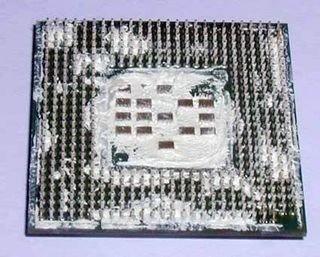VapoChill Puts a Pentium 4 with 800 MHz FSB within Reach
The Test Processor: Pentium 4 At 2.26 GHz
What processors could we have used in our 800 MHz project? With this FSB speed as a starting point, the actual bus frequency can be calculated to be 200 MHz. Once the number of information units processed per clock cycle is increased to four (quad-pumped bus of the Pentium 4), we end up with the logical speed of 800 MHz. To judge by previous roadmaps, the new processors will run at 3.2 and 3.4 GHz, which requires 16x and 17x multipliers, respectively.
The following processors satisfy these criteria:
- 1.60 GHz/ 400 MHz FSB;
- 1.70 GHz/ 400 MHz FSB;
- 2.13 GHz/ 533 MHz FSB;
- 2.26 GHz/ 533 MHz FSB.
We didn't even consider using a Pentium 4 clocked at 1.6 or 1.7 GHz because they most likely would have been unable to break the 3 GHz barrier, no matter how powerful the cooling might be. Anyway, models below 2 GHz are still mostly based on the old Williamette processor core, which is ill-suited for overclocking.

Before using the VapoChill, you have to cover the underside of the processor with thermal grease in order to prevent condensation from forming. The downside is obvious in the picture - it's nigh on impossible to get this CPU clean again.
We conducted the tests with a standard Pentium 4 processor factory-clocked at 2.26 GHz and 533 MHz FSB. It was a perfect candidate because it has a 17x multiplier and can be overclocked to a great extent. That doesn't mean our project was easy - it wasn't until we tried out a second refrigerated processor that we managed to top 3 GHz.
Stay on the Cutting Edge
Join the experts who read Tom's Hardware for the inside track on enthusiast PC tech news — and have for over 25 years. We'll send breaking news and in-depth reviews of CPUs, GPUs, AI, maker hardware and more straight to your inbox.
Current page: The Test Processor: Pentium 4 At 2.26 GHz
Prev Page Top Secret: A Sneak Preview Of Intel's Next Pentium 4 Generation Next Page The VapoChill Premium Edition Cooling SystemMost Popular

